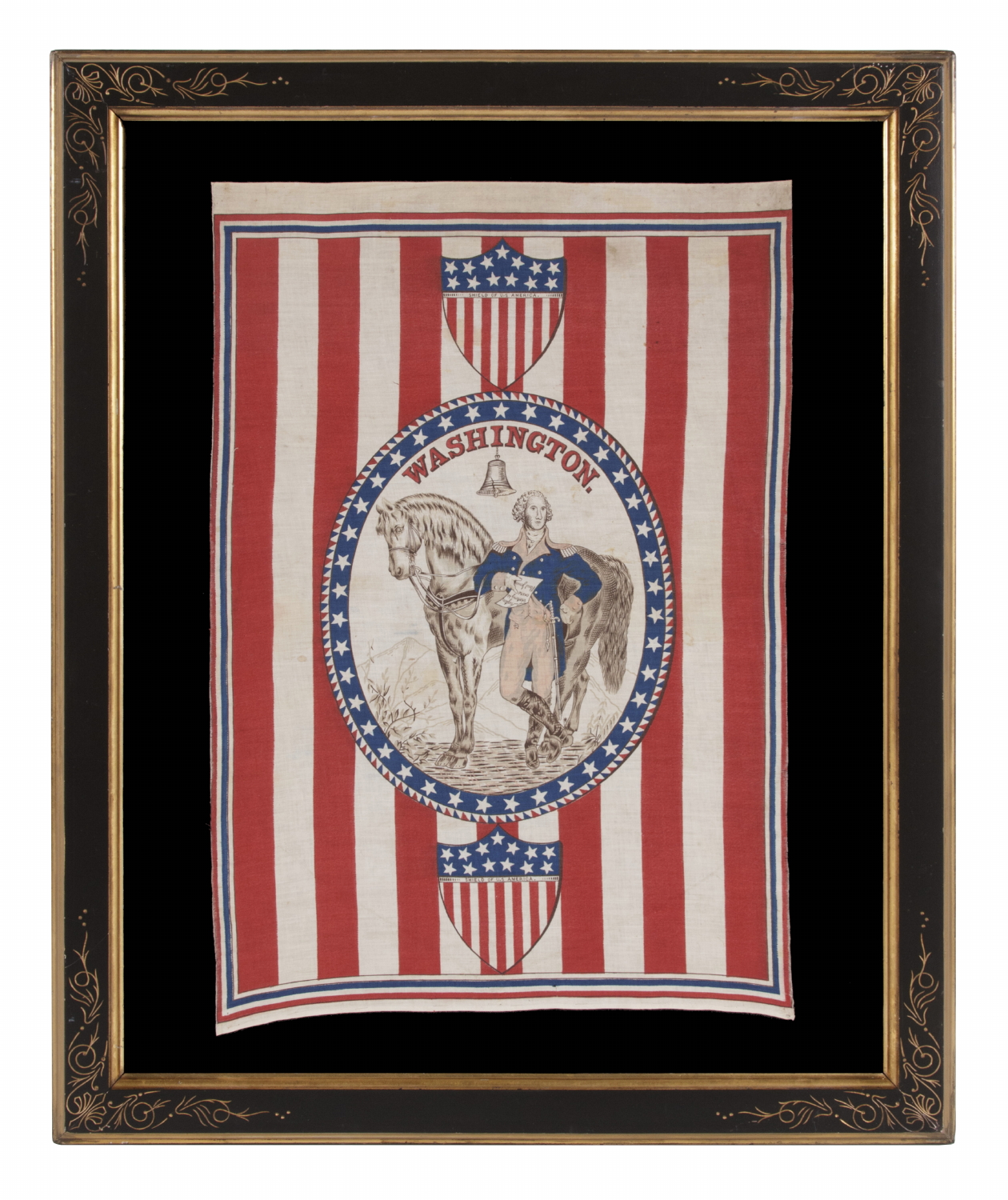
| |
1876 CENTENNIAL CELEBRATION PARADE BANNER WITH OVAL STANDING PORTRAIT OF GEORGE WASHINGTON AND HIS HORSE ON A GROUND OF RED & WHITE STRIPES |
|
| Available: |
Sold |
| Frame Size (H x L): |
33.5" x 27.5" |
| Flag Size (H x L): |
26" x 17.5" |
|
| Description....: |
|
Despite its vertical format, this striking banner, printed on cotton, was intended to be tacked to a wooden staff along its top edge and waved like any horizontal format parade flag, in celebration of our nation’s 1876 centennial of independence. Such use is evidenced by the fact that this banner was found on its original staff, in that exact state.
Past the striking colors and tremendous folk quality of the design, the portrait itself is interesting because it is otherwise unknown. While most printed images of Washington are derived from original paintings or subsequent engravings, this one is unique to this banner, evidently designed specifically for its manufacture. The folk imagery in the interpretation of Washington’s face and hair are particularly great, as-is the exposed note in his hand which reads: “Washington; Victory is Ours; Paul Jones”.
The inclusion of the general’s horse is also of interest. This is probably one of two, either “Nelson” or “Blueskin”, that accompanied him throughout the war (probably Blueskin; note the coloration). Above this is the cracked Liberty Bell and behind Washington is a mountainous landscape. All of this is framed within an oval, blue and red, saw tooth border, inside which are 39 stars.
While there were 38 states as of August 1st, 1876, some flag-makers thought that a 39th state was also soon-to-be added. This didn’t actually occur for another 13 years, but 39 star flags were produced for the Centennial, as were other objects with various representations of 39 stars. Above and below the center medallion are 13 star shields, on the waists of which, in small text, are the words: “Shield of U.S. America”.
This banner is certainly one of the most beautiful and graphic of all printed centennial textiles of this nature. Sometimes examples of it are seen incorporated into quilts made for the centennial celebration, pieced alongside other banners, kerchiefs, parade flags, and carious centennial fabrics. Though the maker is unknown, the same exact banner design was used in the 1880 presidential campaigns of Republican James Garfield and Democrat Winfield Scott Hancock, substituting their bust portraits for the image of Washington and his horse.
An example of this parade banner resides in the collection of the Smithsonian Institution’s Division of Political History. It is documented as item 376 on page 188 of “Threads of History, Americana Recorded on Cloth, 1775 - the Present”, by Herbert Ridgeway Collins (1979, Smithsonian Press). Collins formerly served as the Smithsonian’s curator of Political History and his book is the most comprehensive reference on political textiles.
Mounting: The ebonized and gilded American molding dates to the period between the latter 1840’s and 1870. The flag has been hand-stitched to 100% cotton twill, black in color, which was washed reduce excess dye. An acid-free agent was added to the wash to further set the dye and the fabric was heat-treated for the same purpose. The glazing is U.V. protective acrylic.
Condition: Excellent among known examples. There is very minor foxing and soiling. The colors are exceptional. |
|
|
|
| Collector Level: |
Advanced Collectors and the Person with Everything |
|
| Flag Type: |
Parade flag |
|
| Star Count: |
|
|
| Earliest Date of Origin: |
1876 |
|
| Latest Date of Origin: |
1876 |
|
| State/Affiliation: |
Pennsylvania |
|
| War Association: |
1866-1890 Indian Wars |
|
| Price: |
SOLD |
|
| |
Views: 1801 |
|
|
|

